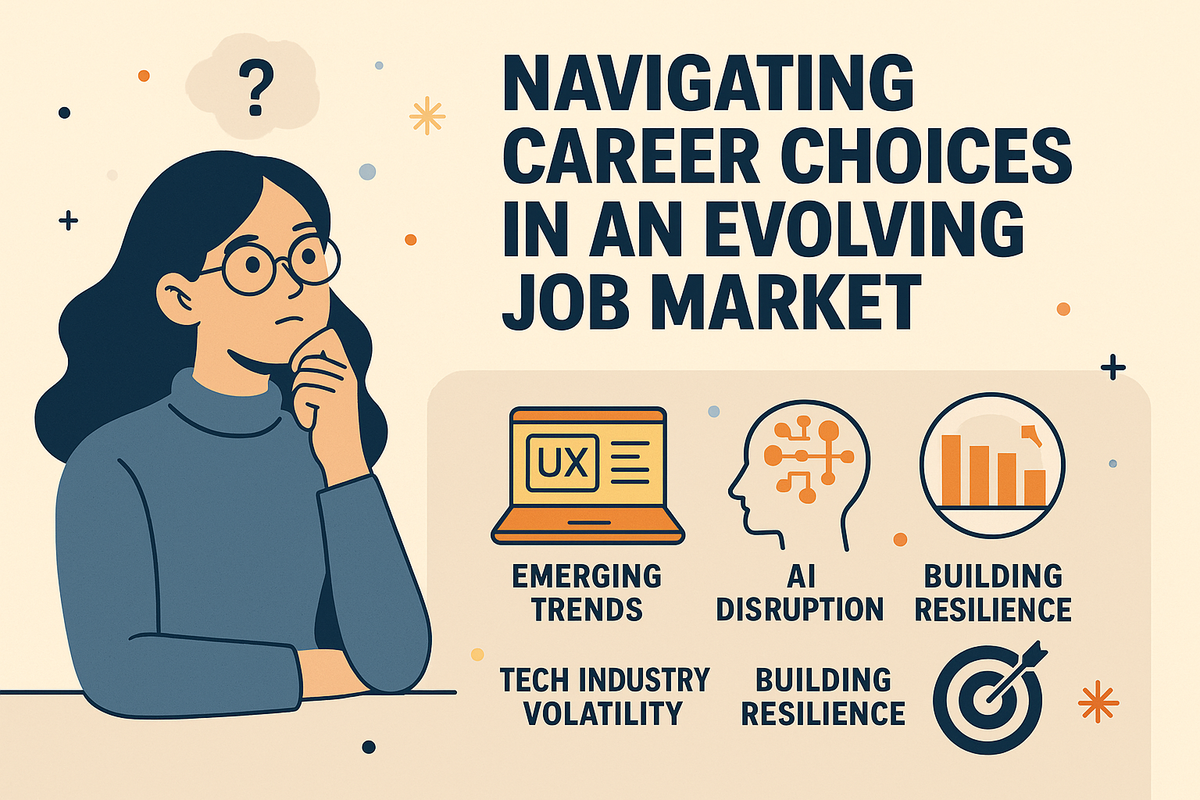Shifting Trends in Career Choices: An Analysis of UX Design, Data Science, and Digital Marketing
This report explores shifting trends in UX design, data science, and digital marketing. It offers insights on job market changes, AI’s impact, and strategies for career resilience, empowering professionals to navigate uncertainty and build sustainable, purpose-driven careers.

The modern economic landscape is characterized by fluidity and constant evolution, exerting a profound influence on professional trajectories. Individuals increasingly recognize the necessity of staying informed about these dynamic shifts to make judicious career decisions. This report provides a comprehensive analysis of primary trends shaping career choices within the United States, focusing on three key sectors experiencing significant transformation: UX design, data science, and digital marketing. The analysis examines current market conditions, emerging opportunities, technological impacts, and strategies for building sustainable careers in these evolving fields.
1. Overview of Key Sector Trends
1.1 User Experience (UX) Design
The User Experience (UX) design field presents a complex picture of both opportunity and challenge in the current economic climate. Analysis from early 2025 reveals fluctuating trends across different UX specializations (Glassdoor, 2025). Product Design roles initially declined in late 2024 before gradually increasing in early 2025, yet competition remains intense as companies prioritize candidates with extensive experience while consolidating design responsibilities.
Product Management roles have maintained relatively stable job postings, hovering between 10,000-12,000 per month, despite restructuring efforts leading to job cuts in some organizations. UX Research has faced a notable downturn, with job postings falling below 1,000 in early 2025, indicating lower demand compared to other UX functions. Design Operations, a more specialized category, shows steady patterns with postings ranging from 30-80 monthly, suggesting continued investment in operational efficiency by certain companies.
HIGHLIGHT: The U.S. Bureau of Labor Statistics projects 7.9% job growth for web and digital interface designers through 2032, with a median annual salary of $98,090 (BLS, 2024).
The overall UX job market in early 2025 appears to be navigating a period of adjustment, marked by accelerating layoffs and hiring slowdowns. Notably, a significant rise in job opportunities within startups represents a potential growth area within the UX landscape. Historical data from 2020-2022 indicated strong demand for UX design skills, with LinkedIn ranking it among the top 5 in-demand skills and Glassdoor including it in their list of best 50 jobs (LinkedIn, 2022; Glassdoor, 2022).
The broader tech industry layoffs have affected the UX job market. February 2025 saw a significant spike in tech industry layoffs reaching over 16,084, reversing the stabilization observed at the end of 2024 (Layoffs.fyi, 2025). This trend of restructuring and job cuts has elevated competition for reduced available roles. However, examining longer-term trends reveals a different picture. Comparing UX research job openings in 2023 to 2018 shows a 53% increase over those five years, suggesting the market is returning to more stable, pre-pandemic hiring levels rather than experiencing continuous decline (McCarthy, 2023).
Several emerging trends are shaping UX design's future. A critical focus is integrating Artificial Intelligence (AI) into UX practices. To remain competitive in 2025, UX professionals must develop expertise in designing for AI, expand cross-functional skills including AI coding and data analysis, and demonstrate how design decisions contribute to business outcomes (Nielsen Norman Group, 2025). The increasing prevalence of AI development itself may drive greater need for skilled UX designers who understand effective human-AI collaboration.
The terminology within digital design is evolving, with ongoing discussions surrounding "UX/UI designer" versus "product designer" roles. Despite this evolution, professionals who oversee all product design components remain in demand regardless of title. Future developments may include more specialized roles such as interactive designers or VUI (Voice User Interface) designers, reflecting deepening expertise in specific user interaction areas.
1.2 Data Science
The data science career path continues to exhibit strong demand and promising growth projections. The U.S. Bureau of Labor Statistics projects 36% growth in data scientist employment from 2023-2033, significantly faster than average for all occupations (BLS, 2024). This robust growth is expected to generate approximately 20,800 job openings annually over the next decade. The median annual wage for data scientists in 2024 was $112,590, highlighting the attractive compensation in this field.
Artificial Intelligence is significantly impacting the data science job market through both automation of certain tasks and creation of entirely new roles. Forecasts suggest AI and data processing trends will create 11 million new jobs globally by 2030 (World Economic Forum, 2024). Machine learning remains fundamental within the AI domain, with 77% of AI-related job postings requiring expertise in this area (Burning Glass Technologies, 2024). While some routine data analysis tasks may become automated, rapid AI advancement is generating demand for data scientists who can develop machine learning models, build AI-driven applications, and transform raw data into actionable business intelligence.
Employers increasingly seek candidates with versatile skillsets, domain-specific expertise, and strong educational credentials. A significant portion (57%) of data science job postings in 2025 targeted "Versatile Professionals" with expertise across multiple domains, while 38% sought "Domain Experts" with specialized skills in areas like machine learning (Harvard Business Review, 2025).
HIGHLIGHT: There is a clear trend toward higher educational requirements, with 70% of data science job postings in 2025 specifying a need for a data science degree, increasing from 47% in 2024.
Core programming skills in Python and SQL remain essential, with growing demand for skills in AI, machine learning, cloud computing, data visualization, and effective communication of complex insights.
1.3 Digital Marketing
The digital marketing sector is experiencing robust demand and positive growth projections. LinkedIn identified "Digital Marketing Specialist" among the top 10 most in-demand jobs, with approximately 860,000 openings (LinkedIn, 2024). The U.S. Bureau of Labor Statistics anticipates a "slightly better than average" job outlook for the overall marketing field, projecting a 10% increase by 2031, translating to about 33,700 new jobs (BLS, 2024). Specifically within digital marketing, 10% growth is expected from 2021-2031, fueled by advancements in AI, virtual and augmented reality, and content marketing. The average salary for digital marketers is around $58,000, with significant potential for upward mobility.
Within digital marketing, certain roles show particularly high demand. Employers actively seek experts in internet marketing, search engine marketing (SEM), and social media marketing. In-demand roles include marketing analytics specialists, mobile marketing professionals, content experts, and social media marketers (American Marketing Association, 2024). Experience in social media, content strategy, Search Engine Optimization (SEO), and analytics are among the most frequently requested qualifications.
Artificial Intelligence is significantly influencing digital marketing, presenting both opportunities and uncertainties. As AI technology becomes more adept at content creation, the need for skilled marketers to develop overarching strategies guiding AI-generated content application is increasing. AI is impacting content creation, market research, and data analysis. While not expected to completely replace digital marketers soon, candidates with AI-related skills gain distinct advantages in the job market and may command higher salaries. Currently, many companies are still in early stages of testing and integrating AI into their digital marketing workflows.
2. The Impact of Technology on Career Landscapes
Technological advancements, particularly in Artificial Intelligence and automation, are fundamentally reshaping job roles across industries. AI integration creates specialized positions while automating routine tasks. In UX design, AI development increases demand for professionals skilled in human-AI collaboration interface design. Technology's impact extends beyond creating new roles; it transforms existing ones and automates previously human-performed tasks.
HIGHLIGHT: Despite concerns about job displacement, the World Economic Forum projects a net increase of approximately 78 million jobs globally by 2030 directly resulting from AI, though many new roles will require specialized qualifications beyond typical current skillsets (World Economic Forum, 2024).
Forecasts indicate that while AI and automation may displace some jobs, they're projected to generate significantly more new employment opportunities globally (McKinsey Global Institute, 2024). This suggests a net positive impact on the overall job market, though requiring substantial shifts in required skills. Generative AI potentially automates considerable portions of current employee workloads across various industries. In digital marketing, AI advancements alongside virtual and augmented reality drive growth, enabling more personalized, efficient marketing strategies.
Despite concerns about job displacement, expert consensus suggests rapid AI development will ultimately create new job types, even as some existing skills become less relevant (MIT Technology Review, 2024). This transformative AI impact has prompted widespread concern, with a significant majority of U.S. employees expressing fears about job security due to increasing workplace AI prevalence. Despite these anxieties, the World Economic Forum projects a net increase of approximately 78 million jobs globally by 2030 directly resulting from AI, though many new roles will require specialized supervisory qualifications beyond typical current skillsets (World Economic Forum, 2024).
The tech industry is experiencing a transformative period driven by AI, creating new job markets for professionals who effectively interpret and leverage AI-generated data, especially those with strong analytical expertise. The rapid pace of technological change contributes to shorter "skill half-life," as job skills become obsolete more quickly. This underscores the critical need for continuous learning and upskilling to maintain relevance in the evolving job market.
3. Navigating Volatility in the Tech Industry
The technology industry has experienced notable volatility, marked by significant layoffs in 2023 continuing into early 2025. This workforce reduction trend stems from interconnected factors. A primary reason is correcting pandemic-era over-hiring, when technology demand surged. As pandemic-driven demand normalized, many tech companies found themselves with inflated workforces misaligned with current market needs.
Strategic realignments toward emerging technologies, particularly AI and automation, have significantly influenced recent layoffs. Companies increasingly focus investments on developing AI-powered solutions, restructuring workforces to prioritize AI-related roles and skillsets. Broader macroeconomic conditions, including rising interest rates and recession fears, have further contributed. Higher interest rates increase capital costs, making companies more cautious about spending and implementing cost-cutting measures including layoffs. Investor pressure on tech companies to demonstrate profitability and sustainable growth has intensified, prompting even profitable firms to reassess operational efficiency and workforce size.
These widespread layoffs significantly impact job security and career planning for technology sector workers. Increased competition for reduced available roles, particularly in areas like UX design, creates challenges for job seekers. The previous perception of tech as virtually layoff-proof has shattered, forcing many professionals to confront potential job loss for the first time. The current environment represents a "mad scramble for jobs," with individuals experiencing career interruptions and financial strain (Wall Street Journal, 2024).
Despite relatively low overall unemployment, many tech workers continue struggling to find new employment, suggesting potential mismatches between laid-off workforce skills/expectations and available position requirements.
Despite overall tech industry volatility, certain sectors offer job security and significant growth opportunities. Cybersecurity remains remarkably robust with substantial, growing demand for skilled professionals.
HIGHLIGHT: Global cybersecurity job vacancies have grown dramatically, projected to remain at an estimated 3.5 million unfilled positions in 2025, with over 750,000 vacancies in the United States (Cybersecurity Ventures, 2024).
This contrasts starkly with layoffs in other tech sectors, indicating fundamental, persistent need for cybersecurity expertise. The U.S. Bureau of Labor Statistics projects 33% growth for information security analysts from 2023-2033, underscoring strong future outlook for this specific technology area (BLS, 2024).
The technology industry's inherent volatility stems from several key factors. Rapid technological innovation creates uncertainty about which companies and technologies will emerge as long-term leaders. Many tech companies' nature as growth stocks makes their share prices particularly sensitive to interest rate movements and news suggesting future growth might not meet previously high expectations. Artificial Intelligence currently represents a major volatility source, with intense competition driving significant stock valuation fluctuations as investors reassess capital expenditure strategies and disruption potential. Despite this inherent volatility, the tech industry continues attracting talent due to cutting-edge innovation opportunities and potential significant long-term rewards.
4. Essential Skills for the Future of Work
Navigating the evolving career landscape requires acquiring and continuously developing essential skills. The future of work demands blending technical expertise with interpersonal abilities to thrive in dynamic environments.
Critical hard skills currently in high demand across sectors include proficiency in Artificial Intelligence, data analysis, cloud computing, and cybersecurity (LinkedIn Skills Report, 2024). In UX design, integrating AI into design processes and possessing skills in AI coding, product strategy, and data analysis are increasingly important. Data science relies heavily on data engineering, machine learning, deep learning, and cloud platforms, alongside programming languages like Python and SQL. Digital marketing sees growing demand for professionals skilled in marketing data analysis, AI, automation, and emerging technologies like virtual and augmented reality. The increasing sustainability focus drives need for "green skills" including sustainable finance knowledge and circular economy expertise.
Equally important are soft skills enabling effective collaboration, adaptation to change, and complex problem-solving. These include adaptability, communication, problem-solving, and critical thinking. UX/UI designers need to broaden skillsets beyond technical tools to include strong interpersonal abilities. In the AI age, creative problem-solving and learning dedication are paramount. The ability to communicate complex information clearly and persuasively is highly valued across various roles, including digital marketing and sustainability positions.
Given rapid technological advancement and ever-changing job market demands, continuous learning and upskilling are essential for maintaining career relevance and building sustainable professional lives. This commitment to lifelong learning ensures individuals can adapt to new technologies, acquire in-demand skills, and remain competitive in chosen fields.
5. Strategic Career Planning for Long-Term Success
In a constantly evolving job market, strategic career planning has become indispensable for achieving sustained success and fulfillment. This involves a proactive, thoughtful approach to defining one's professional trajectory and taking deliberate steps toward desired outcomes.
HIGHLIGHT: A fundamental aspect of effective long-term career planning is establishing SMART goals—ensuring goals are Specific, Measurable, Achievable, Relevant, and Time-bound—providing clarity and progress roadmaps (Doran, 1981).
Once long-term goals are defined, creating detailed career roadmaps becomes crucial, outlining necessary steps, skills to acquire, and experiences to gain at each career stage to reach desired objectives.
Building and nurturing strong professional networks is another vital component. Engaging with industry professionals, attending events, and joining relevant organizations can open doors to new opportunities, provide valuable insights, and facilitate idea exchange. Seeking guidance from experienced mentors can offer personalized advice, support, and direction, helping navigate career advancement complexities.
Finally, in our rapidly changing world, commitment to continuous learning and skill development is paramount. Staying abreast of industry trends, acquiring new technical skills, and honing soft skills are essential for remaining competitive and adaptable. Long-term career planning requires regular reflection, evaluation, and adjustment responding to personal growth and evolving professional landscape demands.
6. Aligning Personal Values and Passions with Career Choices
For individuals seeking enduring job satisfaction and fulfillment, aligning career paths with deeply held personal values and passions is paramount. When work resonates with what truly matters to individuals, it fosters authenticity, motivation, and overall well-being.
The initial alignment step involves thorough self-assessment to identify core personal values and passions. This introspection might include reflecting on joy-bringing experiences, exploring various interests, assessing natural talents, and considering most important principles and beliefs (Schein, 2013). Values assessments and personality tools can help pinpoint these fundamental aspects.
Once personal values and passions are identified, research various career paths and industries to find strong alignment. This might involve exploring different roles, investigating company values and missions, and conducting informational interviews with professionals in interesting fields. Setting clear career goals rooted in these values provides direction and purpose. Continuously evaluate whether current career paths remain aligned with evolving values and aspirations, remaining open to adaptation ensuring ongoing fulfillment.
The benefits of finding meaningful work resonating with personal beliefs are numerous. Research shows it leads to increased job satisfaction, higher motivation and engagement, greater purpose sense, and improved overall well-being (Rosso et al., 2010). When individuals are passionate about their work, challenges often become opportunities, making each day more fulfilling.
7. Building a Sustainable and Resilient Career
In an era marked by rapid technological advancements and frequent economic shifts, building sustainable and resilient careers has become critical across all fields. A sustainable career endures long-term, aligning with individual interests, strengths, and values while providing ongoing learning and growth opportunities. Resilience refers to adapting and bouncing back from career path setbacks and disruptions.
Several key strategies contribute to building sustainable and resilient careers. Taking ownership of professional development and actively charting career courses aligned with personal goals and values provides foundation. Cultivating growth mindsets—believing abilities and knowledge can develop through dedication and effort—is crucial for navigating challenges and embracing continuous learning (Dweck, 2006). Regularly documenting organizational value and contributions helps maintain alignment with company objectives and facilitates career adjustments. Building strong professional relationships with energy-providing and inspiring individuals enhances career sustainability. Maintaining long-term career visions while flexibly adapting to changing circumstances is essential for navigating inevitable professional journey fluctuations.
Increasing global environmental sustainability focus has created growing demand for "green skills" across sectors. These skills, encompassing environmental responsibility and ESG (Environmental, Social, Governance) practice knowledge, are increasingly valued as businesses strive for more sustainable operations. Pursuing sustainability careers or acquiring green skills can represent stable, impactful long-term career paths (World Economic Forum, 2023).
Developing resilience is equally important for career longevity. This involves setting clear career goals providing direction and purpose. Building strong support networks of friends, family, and professional contacts offers encouragement and perspective during challenges. Enhancing problem-solving skills enables more effective obstacle navigation and adaptation to new situations. Practicing self-care to maintain physical and emotional well-being is crucial for handling stress and sustaining long-term performance. Finally, reflecting on setbacks, learning from them, and adapting approaches ensures continued growth and resilience facing career disruptions.
8. Case Studies of Successful Career Navigation
Examining individuals who have successfully navigated significant career changes or overcome substantial professional challenges provides valuable insights and inspiration for those facing similar transitions.
Howard Schultz initially worked in sales before recognizing a gap in the U.S. market for European-style coffeehouse experiences. He took calculated risks by joining and eventually acquiring Starbucks, transforming it into a global phenomenon (Schultz & Gordon, 2011). His success highlights the importance of identifying opportunities and venturing into new territory.
Vera Wang, after careers in figure skating and journalism at Vogue, transitioned to fashion design at age 40. By leveraging previous industry knowledge and pursuing her passion with dedication, she became renowned in bridal couture. Her story demonstrates it's never too late to pursue new career paths (Crittenden, 2010).
Jeff Bezos, a former financial analyst, founded Amazon by recognizing the internet's untapped potential. His ability to embrace innovation, create clear plans, and persist through challenges led to creating one of the world's largest companies (Stone, 2013). J.K. Rowling, who faced personal and financial difficulties while working as a secretary, persevered through numerous rejections to eventually publish the Harry Potter series, testifying to passion and resilience power (Rowling, 2008).
Beyond these well-known examples, many individuals successfully navigate career changes by leveraging transferable skills. One instance involves a professional transitioning from retail to emergency medical services by recognizing that attention to detail and customer service skills applied in healthcare. This highlights the value of identifying and capitalizing on existing competencies when making career shifts.
Resilience is a recurring theme in successful career navigation. Steve Jobs, after being fired from Apple, channeled energy into creating Pixar before returning to Apple and leading it to remarkable success (Isaacson, 2011). This demonstrates the ability to bounce back from major setbacks and find new achievement avenues. Case studies also illustrate the benefits of seeking external support, such as career coaching, to build resilience and navigate significant career transitions.
9. Conclusion
This analysis underscores the significant, continuous shifts occurring in career choice landscapes. Driven by relentless technological advancement, ever-changing global economic dynamics, and evolving individual priorities, the work world remains in constant flux. The report examined key trends within high-demand sectors of UX design, data science, and digital marketing, illuminating their current states and future-shaping forces. The pervasive influence of disruptive technologies, particularly Artificial Intelligence, and recent tech industry volatility highlight the need for agile, forward-thinking approaches to career planning and talent development.
HIGHLIGHT: A central emerging theme is adaptability's paramount importance. In a world of rapidly evolving job roles and required skills, the ability to learn new competencies, embrace change, and pivot career paths as needed becomes increasingly critical for long-term success.
Continuous learning is no longer supplementary but fundamental for remaining competitive and relevant in tomorrow's job market. Acquiring skills in high-demand areas such as AI, data science, cybersecurity, and sustainability provides professionals with significant advantages.
Strategic career planning provides vital frameworks for navigating this dynamic environment. Setting clear, achievable goals, developing comprehensive career roadmaps, and building strong professional networks are essential steps for controlling professional trajectories. Furthermore, aligning career choices with deeply held personal values and passions increasingly drives long-term job satisfaction and overall well-being.
While challenges such as potential job displacement due to automation and periods of economic uncertainty must be acknowledged, shifting career trends also create numerous exciting opportunities across industries. Individuals cultivating growth-oriented mindsets, developing resilience facing setbacks, and remaining informed about evolving labor market demands will navigate these changes effectively, building fulfilling, sustainable, and successful careers in years ahead.
References
American Marketing Association. (2024). Digital marketing trends report 2024. Chicago, IL: AMA.
Burning Glass Technologies. (2024). The digital skills gap in the AI economy. Boston, MA: Burning Glass.
Bureau of Labor Statistics. (2024). Occupational outlook handbook. U.S. Department of Labor. https://www.bls.gov/ooh/
Crittenden, A. (2010). Vera Wang: On her own terms. Forbes. Retrieved from https://www.forbes.com/
Cybersecurity Ventures. (2024). Cybersecurity jobs report 2025: Global figures and forecasts. Northport, NY: Cybersecurity Ventures.
Doran, G. T. (1981). There's a S.M.A.R.T. way to write management's goals and objectives. Management Review, 70(11), 35-36.
Dweck, C. S. (2006). Mindset: The new psychology of success. Random House.
Glassdoor. (2022). 50 best jobs in America for 2022. Mill Valley, CA: Glassdoor.
Glassdoor. (2025). UX design industry analysis Q1 2025. Mill Valley, CA: Glassdoor.
Harvard Business Review. (2025). The evolving expectations for data scientists. Boston, MA: Harvard Business School Publishing.
Isaacson, W. (2011). Steve Jobs. Simon & Schuster.
Layoffs.fyi. (2025). Tech layoff tracker February 2025. https://layoffs.fyi/
LinkedIn. (2022). Most in-demand skills report 2022. Mountain View, CA: LinkedIn.
LinkedIn. (2024). Jobs on the rise report 2024. Mountain View, CA: LinkedIn.
LinkedIn Skills Report. (2024). Global skills report: The skills transforming the workplace. Mountain View, CA: LinkedIn.
McCarthy, J. (2023). UX industry hiring trends: 2018-2023 comparative analysis. UX Collective.
McKinsey Global Institute. (2024). The future of work after COVID-19. McKinsey & Company.
MIT Technology Review. (2024). AI and the future of work: An evolving landscape. Cambridge, MA: MIT Technology Review.
Nielsen Norman Group. (2025). UX careers in the age of AI. Fremont, CA: Nielsen Norman Group.
Rosso, B. D., Dekas, K. H., & Wrzesniewski, A. (2010). On the meaning of work: A theoretical integration and review. Research in Organizational Behavior, 30, 91-127.
Rowling, J. K. (2008). The fringe benefits of failure, and the importance of imagination. Harvard Commencement Address.
Schein, E. H. (2013). Career anchors: The changing nature of work and careers (4th ed.). Wiley.
Schultz, H., & Gordon, J. (2011). Onward: How Starbucks fought for its life without losing its soul. Rodale.
Stone, B. (2013). The everything store: Jeff Bezos and the age of Amazon. Little, Brown and Company.
Wall Street Journal. (2024). Tech's new reality: Job insecurity after a decade of growth. New York: Dow Jones & Company.
World Economic Forum. (2023). Green skills outlook 2030. Geneva: World Economic Forum.
World Economic Forum. (2024). The future of jobs report 2024. Geneva: World Economic Forum.


